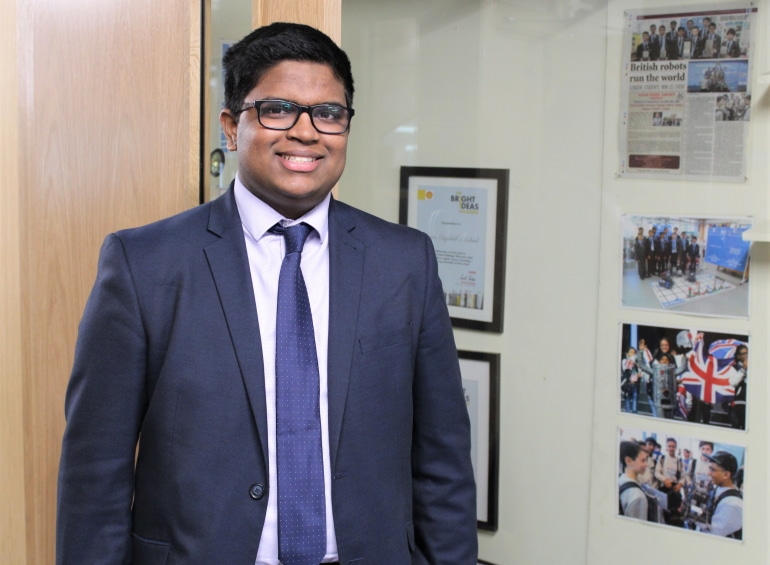
Year in Industry placements are neither a common target for QE leavers nor are they easy to obtain – just 750 are offered nationwide annually – yet sixth-former Deshraam Ganeshamoorthy has successfully gained one, thanks to a glittering CV and some deft interview preparation.
Deshraam, of Year 13, capitalised on his national successes with a QE robotics team over the last four years to impress bosses at the Cambridge engineering consultancy interviewing him for his placement.
Now he is looking forward to spending next year at Springboard Pro, which develops advanced medical devices, before going on to university to read Mechanical Engineering.
Head of Year 13 Helen Davies said: “Whilst a large majority of our A-level students head on to leading universities straight after school or after a conventional gap year, there are some other interesting and potentially valuable vocational routes, with the Year in Industry programme among these. Deshraam is to be congratulated on the work he did to investigate and achieve this, and we wish him every success.”
Deshraam first came across the UK’s Year in Industry scheme when he was looking through the Engineering Design Trust website to learn more about the trust’s summer courses. The scheme places around 750 young people annually in engineering, science, IT, and business, where most work full-time before going on to join degree courses.
His interest piqued, he realised that a placement would enable him to pursue the things he loves most about engineering: “The ability to take a client’s challenge, create a design brief and through iteration go from simple sketches to a final product.”
“I felt that the skills I would learn from working as an engineer would help me greatly when studying for my degree and into the future.”
After consulting QE’s Head of Technology, Michael Noonan, he decided to apply.
“The application process involved creating a CV highlighting my engineering strengths. Here I had the opportunity to briefly describe my IT skills – from using Office to [3D programs] Solidworks and Cura and programming in Python – as well as past projects such as: my GCSE automatic pill dispenser project, the robots built over four years competing in the VEX robotics competitions, and most recently my independent EPQ project exploring the use of soft robotics.” (Soft robotics is a subfield of robotics dealing with the construction of robots from compliant materials similar to those found in living organisms.)
“Over the following months, new vacancies opened up and I had the opportunity to apply to the ones that most interested me.” He was especially keen that his placement should cover Mechanical Engineering, his intended degree subject.
A few months after submitting his first application, he received an invitation to interview with the Cambridge company. “I was sent some documents regarding what the interview might entail, and prepared accordingly.”
The first half of the one-hour interview on Microsoft Teams was spent talking about a project of Deshraam’s choice. “Here I spoke about the most recent robot built by my team, HYBRID, for the VEX Robotics Competition to compete in the game Tower Takeover. During this mini-presentation, I spoke about how we initially analysed the problem, our early more adventurous explorations of design possibilities, and how I used CAD to aid us in designing, manufacturing, and improving this robot. I spoke about where our weaknesses were and how we fixed these, allowing us to succeed at the end of the season and become VEX Robotics UK National Champions, winning both the Tournament Champions and Excellence trophies.
“The second half of the interview centred around a physics problem that started by looking at the forces and energy involved in the motion of a bungee jumper, but progressed to look at the properties of different materials that could be used for the cord.
“Overall, the interview was an enjoyable experience, and whilst it was challenging at times, I felt that I had done my best to explain how I was thinking through problems before reaching an answer.”
“Having spoken to three employees at the company, researching their work further, and after also speaking to Mr Noonan and Mr Feven [Michael Feven, Assistant Head (Pupil Development)], I felt this opportunity would allow me to learn lots of new things and become a better overall engineer.”
When the offer to work for the company duly arrived a few days later, Deshraam was happy to accept. He will start work there after finishing his Mathematics, Further Mathematics, Physics and Economics A-levels this summer.
He is grateful to the staff who have helped him – “primarily Mr Noonan, for always being willing to answer my questions and give me advice both during this process and over the course of the last seven years.
“I would also like to thank my closest friends at QE for always supporting me and believing in me; I couldn’t have done this without all the great people around me.”
